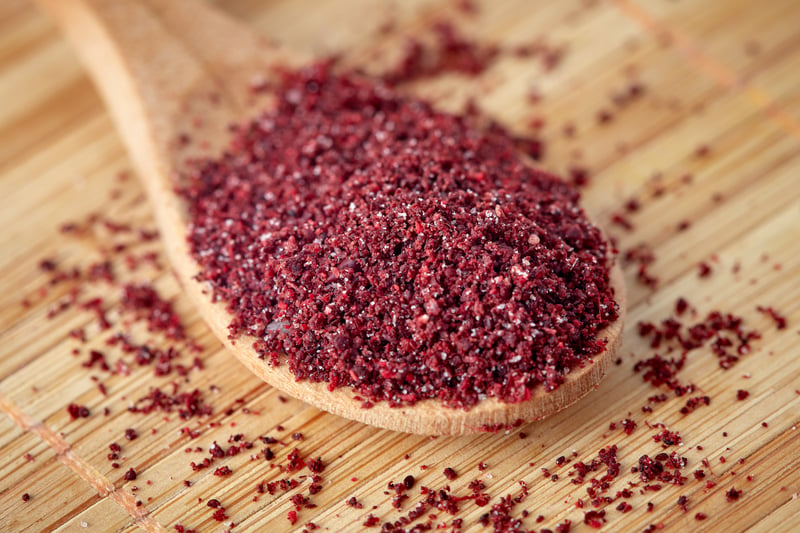14 Health Benefits of Sumac Spice— And How to Use It

When you open up your spice drawer or cabinet, what are your go-to choices? Turmeric? Cinnamon? Chili powder? Cumin? Paprika? Vanilla? Black pepper… How about sumac spice?
What is Sumac Spice?
It’s pretty likely that not only is it missing from your spice rack, but you haven’t even heard of it. Worse, you don’t even know what you’re missing!
With its vibrant, purple-ish-red color and zesty, citrus-like tang, sumac (Rhus coriaria) spice has long been a star of Middle Eastern and Mediterranean cooking. The berries, which are a relative of the cashew family, can be eaten whole, but it’s more common to find them ground up to spice up dishes. It can be used to add pizazz to just about any recipe. Anywhere you might use lemon juice to brighten a dish, sumac can be used instead, though it’s less tart and more balanced.
Health Benefits of Sumac Spice
The allure of sumac doesn’t end with its delectable and versatile flavor. It’s also an antioxidant powerhouse, which allows it to boast some pretty impressive health claims. First off, it has a remarkable antioxidant profile as it provides polyphenols and flavonoids like gallic acid, tannins, 1 and quercetin, as well as loads of vitamin C.
Research has found that health benefits of sumac spice may include:
- Lower blood pressure 2
- Control blood sugar levels 1
- Reduce triglyceride and LDL cholesterol levels 3
- Decrease the risk of heart disease among people with type 2 diabetes 1
- Decrease muscle pain during exercise 4
- Improve insulin resistance 5, 6
- Boost leptin levels, which may help suppress appetite 1
- Decrease fat absorption 7
- Reduce the risk of oxidative stress 8
- Decrease bone loss 9
- Ease respiratory and digestive complaints
- Ease discomfort of urinary tract infections
- Help the body fight unwanted inflammation
- Help support the body during cold and flu season 10
While some studies used higher amounts, most of the health benefits of sumac have been found at a mere 3 grams per day (less than a teaspoon), and benefits are reportedly noticeable within three months.

How to Use Sumac Spice
Sumac is highly versatile. It can be found in pill form, but the tastiest way to use it is by adding it to recipes using the full berries, or more often, the dried and ground up berries as a spice. Some of the popular dishes that include sumac are:
- Fruit smoothies (it mixes well with fruits and yogurt)
- As a dry rub to use on a variety of meats
- In marinades
- In dressings and vinaigrettes
- Added to yogurt sauces
- As part of za’atar, which is a mixture of sumac, sesame seeds, salt, thyme, and other spices
- Sprinkled over foods before serving, such as
- Vegetables
- Lamb
- Chicken
- Fish
- Eggs
- Tofu
- Salads and fresh greens (especially when combined with mint)
- Rice and other grains
- Bread
- Hummus and other dips
- Sour cream
- Beans (especially chickpeas and black-eyed peas)
- Popcorn
- Bloody Mary drinks
- In “Sumac-Ade” or Sumac Tea
- Combined with yogurt and fresh fruit (and perhaps a touch of honey)
Who Shouldn’t Use Sumac Spice?
Because sumac is in the same family as cashews, folks who are allergic to tree nuts should work with their doctors and be very careful to ensure they are not also allergic to sumac. The same is true of mangos. If you experience any issues like itching, hives, or swelling after you consume sumac, stop using it, and consult with a doctor familiar with food allergies.
In addition, people who are underweight or who have difficulty maintaining their weight should not consume sumac daily as it may block the absorption of fat from the small intestines.
And if you use any medications to help lower blood sugar or cholesterol levels, consume only low to moderate amounts and let your doctor know you’re including it in your diet, as it could negatively interact with such medications.


 7 Signs Your Body is Seriously Low on Collagen (not just wrinkles)
7 Signs Your Body is Seriously Low on Collagen (not just wrinkles) Health Expert: "Turmeric Doesn't Work (unless...)"
Health Expert: "Turmeric Doesn't Work (unless...)" 3 Warning Signs Your Probiotic Supplement is a Total Waste
3 Warning Signs Your Probiotic Supplement is a Total Waste

